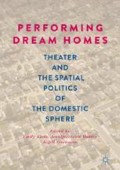Abstract
In her discursive study of the domestic, Glover details the creation of Rachel’s House, a play crafted out of verbatim excerpts from interviews with residents of a residential community recovery program in the Franklinton neighborhood of Columbus, Ohio. In the play, Rachel’s House is a domestic space constructed and enacted through the labor of talk—what Glover calls home work. It is also a space for experimentation and recovery, made manifest through the iterative process of self-narration, an activity explicitly presented as the essential labor of this home. Glover shows how Rachel’s House is not separate from, but always in contact with, the conditions that make it necessary, and how its performance invites the audience into a home where risk and recovery are fundamental to the environment.
Access this chapter
Tax calculation will be finalised at checkout
Purchases are for personal use only
Notes
- 1.
Performances took place at the Ohio Reformatory for Women in Marysville, as well as three locations around Columbus.
- 2.
Rachel’s House boasts an anti-recidivism rate of 86% among all residents, including those who complete the program as well as those who leave before completing the program. According to the most recent available measures from the Ohio Department of Rehabilitation and Corrections (2017) the average anti-recidivism rate in the state is 70%.
- 3.
Patricia O’Brien, Making It in the “Free World”: Women in Transition from Prison (New York: SUNY Press, 2001), 14–15.
- 4.
Recently, contributions to the literature have worked to correct the overgeneralization of men’s experiences on to formerly incarcerated women’s. For further information, see Maycock/Sheridan, O’Brien, Ahmed, and Salem et al.
- 5.
Paula Maycock and Sarah Sheridan, “At ‘Home’ In Prison? Women and the Homelessness-Incarceration Nexus,” Irish Probation Journal 10 (Oct 2013): 135.
- 6.
National Health Care for the Homeless Council, p. 1.
- 7.
“Belle” is an alias, as are all names in the play.
- 8.
The name of the home and community recovery program “Rachel’s House” is an explicit reference to the Old Testament passage Jeremiah 31:15. “A Voice is heard in Ramah, mourning and great weeping, Rachel weeping for her children and refusing to be comforted, because they are no more.”
- 9.
Amanda Stewart Fisher, “Trauma, Authenticity and the Limits of Verbatim,” Performance Research 16, no. 1 (2011): 117.
- 10.
Alison Forsyth, Introduction to The Methuen Drama Anthology of Testimonial Plays (London: Bloomsbury, 2014), 2–3.
- 11.
Linda Alcoff, “The Problem of Speaking for Others,” Cultural Critique no. 20 (Winter 1991–1992): 30.
- 12.
Several of the people whose stories were represented in the play were in the audience for the May 2014 performances as well. Residents did not participate in rehearsals, performances, or talkbacks due to the importance of their continued anonymity to their recovery and safety, though several spoke with McCartney and the performers portraying them.
Works Cited
Alcoff, Linda. “The Problem of Speaking for Others.” Cultural Critique, no. 20, Winter 1991–1992, pp. 5–32.
Bureau of Research and Evaluation. “Recividism Update – 2017.” Ohio Department of Rehabilitation and Corrections, June 2018.
Fisher, Amanda Stewart. “Trauma, Authenticity and the Limits of Verbatim.” Performance Research, vol. 16, no. 1, 2011.
Forsyth, Alison. The Methuen Drama Anthology of Testimonial Plays. Bloomsbury, 2014.
Maycock, Paula and Sheridan, Sarah. “At ‘Home’ In Prison? Women and the Homelessness-Incarceration Nexus.” Irish Probation Journal, vol. 10, October 2013, pp. 118–140.
McCartney, Nicola. Rachel’s House. Multiple drafts, April 2013–May 2014.
National Health Care for the Homeless Council. “Incarceration and Homelessness: A Revolving Door of Risk.” In Focus: A Quarterly Research Review of the National HCH Council, vol. 2, no. 2, November 2013.
O’Brien, Patricia. Making It in the “Free World”: Women in Transition from Prison. SUNY Press, 2001.
Tamas, Sophie. “Writing Trauma: Collisions at the Corner of Art and Scholarship.” Theatre Topics, vol. 22, no. 1, March 2012, pp. 39–48.
Author information
Authors and Affiliations
Editor information
Editors and Affiliations
Rights and permissions
Copyright information
© 2019 The Author(s)
About this chapter
Cite this chapter
Glover, J. (2019). Staging Recovery as Home Work in Rachel’s House. In: Klein, E., Mobley, JS., Stevenson, J. (eds) Performing Dream Homes. Palgrave Macmillan, Cham. https://doi.org/10.1007/978-3-030-01581-7_6
Download citation
DOI: https://doi.org/10.1007/978-3-030-01581-7_6
Published:
Publisher Name: Palgrave Macmillan, Cham
Print ISBN: 978-3-030-01580-0
Online ISBN: 978-3-030-01581-7
eBook Packages: Literature, Cultural and Media StudiesLiterature, Cultural and Media Studies (R0)

